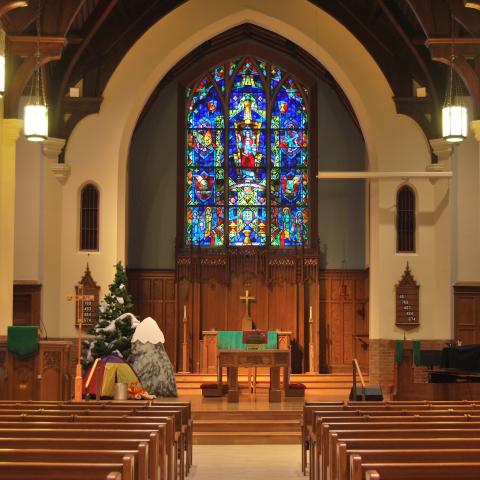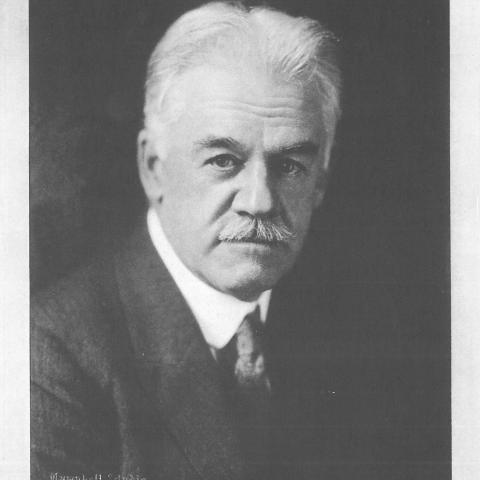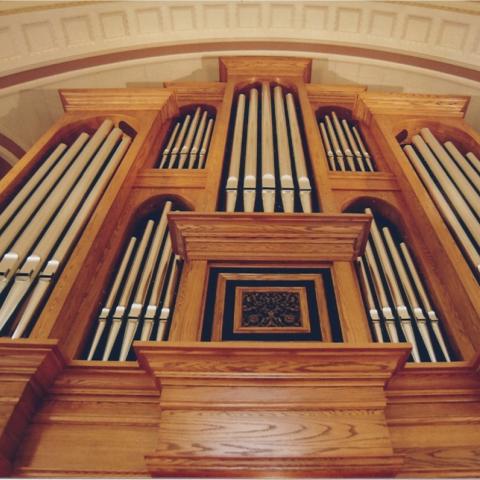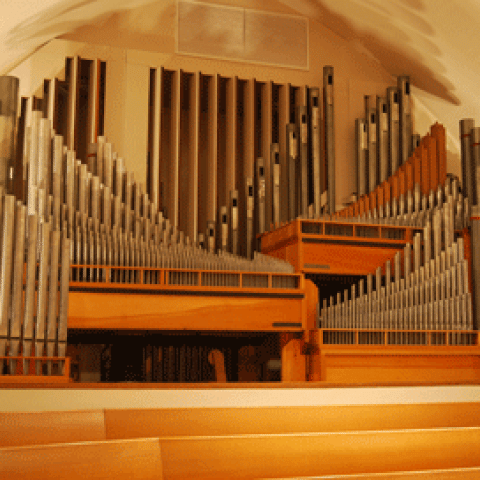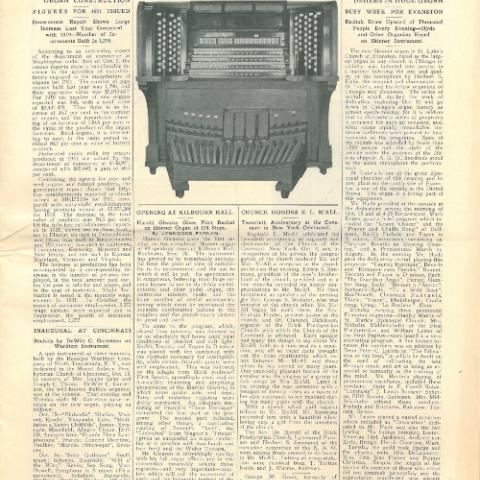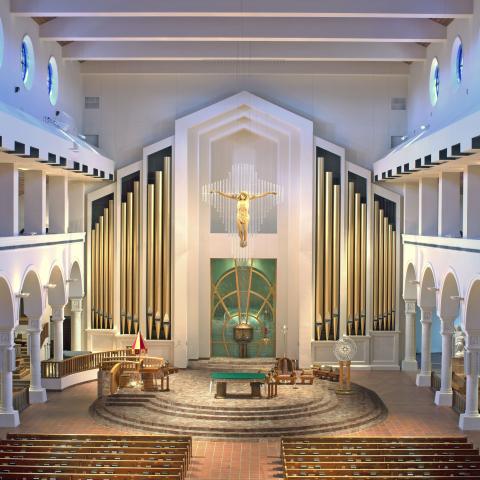Stephen Schnurr is editorial director and publisher of The Diapason, director of music for Saint Paul Catholic Church, Valparaiso, Indiana, and adjunct instructor in organ for Valparaiso University.

As one travels the John F. Kennedy Expressway on the north side of downtown Chicago, one can count the towers of five impressive church edifices that comprise the principal history of Chicago’s Polish Catholics. The heart of Chicago’s “Polonia,” the neighborhoods nearby, has been home to a large number of immigrants who came to the United States from Poland or are of Polish descent. In 1950, Chicago had the largest Polish population outside the city of Warsaw. Today, Polish is the third most frequently heard language in this city, behind English and Spanish.
This is a tale of a church founded for success with large numbers of faithful, only two generations later experiencing alarming decline. Scheduled to close, the parish managed to turn itself around and is now thriving once again, a jewel box of sacred art and architecture, a model of traditional liturgy, and a home for the performing arts, sacred and secular. While many churches have removed their organs or cannot afford to maintain them, here is a parish with no fewer than four pipe organs, all in regular use, for ritual or for concert, or both! Indeed, one could have an “organ crawl” at one address.
Saint John Cantius Catholic Church was founded in 1893 to relieve the overcrowded parish of Saint Stanislaus Kostka and other Polish parishes in this area of the city. Saint Stanislaus had become the largest parish in the world in 1892, and, thus, a division of the parish of 8,000 families had become necessary. The mother parish was located approximately one mile away in its Patrick C. Keely-designed edifice constructed between 1877 and 1881 and housing Johnson & Son opus 553, a two-manual, thirty-three-rank organ.
The Reverend John Kasprzycki, C.R. (Congregation of the Resurrection), was appointed first pastor of Saint John Cantius, a congregation with an immediate roster of 2,000 families. In acquiring the present property on North Carpenter Street between West Fry and Chicago Avenues, some twenty residences were demolished for the new parish campus. The cornerstone of the church was laid by Archbishop Patrick A. Feehan on September 4, 1893. A crowd of an estimated 25,000 attended the event, with music provided by twenty-seven Polish singing societies. By November, the parish school was opened in the basement section of the building. The rectory, located at the corner of Carpenter and Fry, was blessed on December 20. The lower church was blessed by Feehan on Christmas Eve, and the first Mass was celebrated the following day, the traditional founding date of the parish. The upper church was completed and blessed by Archbishop Feehan on December 11, 1898. Construction cost was $130,000. The Romanesque edifice was designed by Adolphus Druiding. A German native then living in Chicago, Druiding designed Saint George and Saint Hedwig Catholic Churches in Chicago, as well. Seating 2,000 persons, Saint John Cantius Church measured 230 feet long, 107 feet wide.
Father Eugene Sedlaczek, C.R., was named second pastor of Saint John Cantius in 1899. Within two years, he oversaw the interior decoration of the church.
The Reverend Stanislaus Rogalski, C.R., was named fourth pastor in 1902. The following year, construction for the present school building commenced, completed in November. The school and the rectory were designed by Henry Schlacks of Chicago. A clock and bells were installed in the 130-foot tower and the church interior painted. Father John Kosinski, C.R., became fifth pastor in 1909. Under his leadership, magnificent stained-glass windows were installed in the church. The Reverend Stanislaus Siatka, C.R., became pastor in 1915. New concrete stairs of monumental proportions were created in front of the church, the basement was remodeled to become an auditorium, and a convent constructed. (At one point, the convent housed forty-seven School Sisters of Notre Dame.) By the parish silver jubilee on December 25, 1918, membership climbed to 23,000 persons, with 2,000 children enrolled in the school.
In the 1950s, numerous neighborhood homes were demolished to make way for what would become known as the Kennedy Expressway, a project that drastically changed the parish environs. Parish membership, which had been in decline, would drop even more drastically. The school closed in 1967. At one point, the parish itself was to be shuttered.
The decline of the parish was reversed in the late 1980s with the appointment of the Reverend C. Frank Phillips, C. R., as pastor, and the parish was soon vibrant and growing, with membership coming from great distances. The Canons Regular of Saint John Cantius, a religious community of men, was founded in the parish in 1998, and this organization now administers the parish. The church interior has been thoroughly restored and enhanced, complemented with countless religious artworks now on display throughout the entire parish campus.
The first organ of record in Saint John Cantius Church was A. B. Felgemaker & Son Opus 723, installed in the choir gallery (the upper of two balconies) in the rear of the nave in 1900.
1900 A. B. Felgemaker & Son Opus 723
GREAT (Manual I)
16′ Double Open Diapason 61 pipes (metal)
8′ Open Diapason (metal) 61 pipes
8′ Doppel Floete (wood) 61 pipes
8′ Viola da Gamba (metal) 61 pipes
8′ Dulciana (metal) 61 pipes
4′ Octave (metal) 61 pipes
4′ Flute d’Amour 61 pipes (wood & metal)
3′ Octave Quinte (metal) 61 pipes
2′ Super Octave (metal) 61 pipes
III Mixture (metal) 183 pipes
8′ Trumpet (metal) 61 pipes
SWELL (Manual II, enclosed)
16′ Bourdon 61 pipes (treble and bass, wood)
8′ Open Diapason 61 pipes (wood & metal)
8′ Stopped Diapason (wood) 61 pipes
8′ Salicional (metal) 61 pipes
8′ Aeolina (metal) 61 pipes
4′ Gemshorn (metal) 61 pipes
4′ Flute Harmonique 61 pipes (metal)
2′ Flageolet (metal) 61 pipes
III Dolce Cornet (metal) 183 pipes
8′ Oboe & Bassoon (metal) 61 pipes
PEDAL
16′ Double Open Diapason 30 pipes (wood)
16′ Bourdon (wood) 30 pipes
8′ Violoncello (metal) 30 pipes
8′ Floete (wood) 30 pipes
Couplers
Great to Pedal
Swell to Pedal
Swell to Great in Sub-Octave
Swell to Great
Swell to Great in Super Octave
Accessories
Forte Combination Great and Pedal Stops
Piano Combination Great and Pedal Stops
Forte Combination Swell and Pedal Stops
Piano Combination Swell and Pedal Stops
Tremolo
Great to Pedal Reversible
Balanced Swell Pedal
Balanced Crescendo Pedal
Bellows Signal
Wind Indicator
The January 1, 1919, issue of The Diapason noted that a W. W. Kimball Company organ was dedicated at Saint John Cantius in December of 1918. Further information on this instrument has not come to light, and it may not have been installed in the church. It is possible that it was placed in the lower church-auditorium or elsewhere.
In 1922, Geo. Kilgen & Son of Saint Louis, Missouri, installed a new three-manual organ in the upper balcony of the church, Opus 3118. In 1927, the builder added an Echo division, placed behind the main altar, as their Opus 3932.
1922/1927 Geo. Kilgen & Son Opus 3118/3932
GREAT (Manual II, enclosed?)
8′ First Open Diapason
8′ Second Open Diapason
8′ Gross Flute
8′ Doppel Flute
8′ Gamba
4′ Octave
4′ Harmonic Flute
2′ Octave
8′ Tuba
Great to Great 16
Great Unison Off
Great to Great 4
Swell to Great 16
Swell to Great 8
Swell to Great 4
Choir to Great 16
Choir to Great 8
Choir to Great 4
Echo to Great 8
SWELL (Manual III, enclosed)
16′ Lieblich Gedeckt
8′ Open Diapason
8′ Stopped Flute (ext 16′ Lieb Ged)
8′ Salicional
8′ Voix Celeste
8′ Muted Viole
4′ Violina
4′ Flute
16′ Fagotto
8′ Cornopean
8′ Fagotto (ext 16′ Fagotto)
8′ Vox Humana
Tremolo
Swell to Swell 16
Swell Unison Off
Swell to Swell 4
Echo to Swell 8
CHOIR (Manual I, enclosed)
16′ Quintadena
8′ Violin Diapason
8′ Melodia
8′ Quintadena (ext 16′ Quintadena)
8′ Dulciana
4′ Flute d’Amore
2′ Piccolo
8′ Clarinet
Tremolo
Choir to Choir 16
Choir Unison Off
Choir to Choir 4
Swell to Choir 16
Swell to Choir 8
Swell to Choir 4
Echo to Choir 8
ECHO (Manual IV, enclosed)
16′ Bourdon
8′ Open Diapason
8′ Bourdon (ext 16′ Bourdon)
8′ String
8′ Celeste (TC)
4′ Flute
2′ Zart Flute (ext 4′ Flute)
8′ Vox Humana
Tremolo
Chimes
PEDAL
32′ Resultant
16′ Open Diapason (wood)
16′ Open Diapason (metal)
16′ Bourdon
16′ Lieblich Gedeckt (Sw 16′ Lieb Ged)
8′ Gamba (Gt 8′ Gamba)
8′ Bass Flute (ext 16′ Bourdon)
8′ Dolce Flute (Sw 16′ Lieb Ged)
16′ Trombone
16′ Fagotto (Sw 16′ Fagotto)
8′ Fagotto (Sw 16′ Fagotto)
Great to Pedal 8
Great to Pedal 4
Swell to Pedal 8
Swell to Pedal 4
Choir to Pedal 8
Choir to Pedal 4
Echo to Pedal 8
By the early 1990s, a one-manual, mechanical-action organ was relocated to the left balcony of the nave. The builder of this instrument was never ascertained, though interior evidence leads one to believe it was likely built around 1881 and perhaps in the New York City area. The organ has since been removed from the church and is now in storage at the retreat facility of the Canons Regular of Saint John Cantius in Lawton, Michigan. It has a 55-note compass (C–G, no high F#) and a Pedal compass of 27 notes (C–D).
MANUAL
8′ Principal
8′ Gamba
8′ Melodia
4′ Flute
2′ Open
PEDAL
16′ Subbass
Manual to Pedal Coupler
About 1996, the Kilgen organ in the rear gallery of the nave was rebuilt by Daniel Bogue and Associates of Downers Grove, Illinois, which closed in 1989. Some pipework was incorporated from an organ formerly in Alvernia High School of Chicago. This organ was removed in late 2011.
1996 Daniel Bogue and Associates organ
GREAT (Manual II, enclosed with Choir, south side)
8′ Principal
8′ Flute (stopped)
4′ Octave (5 basses in façade)
4′ Flute (harmonic from middle C)
2′ Principal (ext 4′ Octave)
IV Fourniture (1′)
8′ Trompette (harmonic from B3)
4′ Clarion (ext 8′ Trompette)
2 blank tabs
Great to Great 16
Great Unison Off
Great to Great 4
Swell to Great 16
Swell to Great 8
Swell to Great 4
Choir to Great 16
Choir to Great 8
Choir to Great 4
Echo to Great 8
SWELL (Manual III, enclosed, north side)
16′ Bourdon (wood)
8′ Principal
8′ Bourdon (ext 16′ Bourdon)
8′ Gamba
8′ Gamba Celeste (TC)
4′ Principal (ext 8′ Principal)
4′ Flute (open wood, harmonic from middle C)
2-2⁄3′ Nazard
2′ Principal
1-3⁄5′ Tierce
IV Plein Jeu
16′ Fagotto (1–12 half-length)
8′ Trumpet
8′ Fagotto (ext 16′ Fagotto)
4′ Clarion (ext 8′ Trumpet)
Tremolo
Swell to Swell 16
Swell Unison Off
Swell to Swell 4
Echo to Swell 8
CHOIR (Manual I, enclosed with Great, south side)
16′ Gemshorn (12 Quintaton basses)
8′ Violin Diapason
8′ Hohl Flute (wood, 12 stopped basses, remainder open)
8′ Gemshorn (ext 16′ Gemshorn)
8′ Gemshorn Celeste (TC)
4′ Principal (ext 8′ Violin Diapason)
4′ Gedeckt (wood)
2′ Flute (harmonic from tenor C)
1-1⁄3′ Larigot (ext 4′ Gedeckt)
III Cymbel
8′ Cromorne
Tremolo
1 blank tab
Choir to Choir 16
Choir Unison Off
Choir to Choir 4
Swell to Choir 16
Swell to Choir 8
Swell to Choir 4
Echo to Choir 8
ECHO (Enclosed, floating)
8′ Bourdon
8′ String
8′ Celeste (TC)
4′ Flute (ext 8′ Bourdon)
2′ Flute (ext 8′ Bourdon)
8′ Vox Humana
1 blank tablet
Tremolo
Chimes
PEDAL
32′ Resultant (fr 16′ Bourdon)
16′ Double Open Diapason (wood, north side)
16′ Contra Bass (E1–E4 in façade, south side)
16′ Bourdon (north side)
16′ Lieblich Gedeckt (Sw 16′ Bourdon)
8′ Octave (ext 16′ Contra Bass)
8′ Bass Flute (ext 16′ Bourdon)
8′ Gedeckt (Sw 16′ Bourdon)
4′ Choral Bass (ext 16′ Contra Bass)
4′ Flute (Sw 16′ Bourdon)
2′ Octavin (ext 16′ Contra Bass)
16′ Contra Trumpet (ext Great 8′ Trompette, full-length)
16′ Contra Fagotto (Sw 16′ Fagotto)
8′ Trumpet (Gt 8′ Trompette)
4′ Clarion (Gt 8′ Trompette)
Great to Pedal 8
Swell to Pedal 8
Choir to Pedal 8
Echo to Pedal 8
ECHO PEDAL (enclosed with Echo)
16′ Bourdon (ext Echo 8′ Bourdon)
8′ Bourdon (fr Echo 8′ Bourdon)
Accessories
10 General Pistons (thumb)
6 Great Pistons and Cancel (thumb)
6 Swell Pistons and Cancel (thumb)
6 Choir Pistons and Cancel (thumb)
6 Echo Pistons and Cancel (thumb)
6 Pedal Pistons and Cancel (thumb)
General Cancel (thumb)
Great to Pedal reversible (thumb and toe)
Swell to Pedal reversible (thumb and toe)
Choir to Pedal reversible (thumb and toe)
Balanced Swell expression shoe
Balanced Great/Choir expression shoe
Balanced Crescendo shoe (with indicator light)
Combination Lock (key)
Sforzando Reversible (thumb and toe, with indicator light)
Wind Indicator
In 2005, Saint John Cantius Church commissioned one of the last organs built by Oberlinger Orgelbau of Windesheim, Germany. The one-manual, mechanical-action instrument resides on the main floor of the nave. Manual compass is 51 notes (C–D). A lever transposes the organ one half-step down (A=415 Hz). The instrument was blessed on May 14, 2005, by the Most Reverend Basil Meeking, Bishop Emeritus of Christchurch, New Zealand.
2005 Oberlinger organ
MANUAL
8′ Traversflöte (tenor B, wood)
8′ Copula (stopped wood)
4′ Gedackt (30 basses stopped wood, remainder open metal)
2′ Principalflöte (18 capped metal basses, remainder open metal)
1-1⁄3′ Quinte (24 capped metal basses, remainder open metal)
1–2f Cymbel (1⁄2′)
Accessory
H–C (transposer)
In August 2008, a two-manual, mechanical-action organ built in 1991 by Alfred Wild of Gottenhouse, France, was installed in the sanctuary of the church. It was on loan to the parish by a nearby resident who was a friend of Father Phillips. The stopknobs are unlabeled. Temperament is Kirnberger. Manual compass is 56 notes (C–G). In October 2015, the organ was moved to the lower balcony at the rear of the church, so that it could be used with the choir or instrumentalists when a small organ is desirable. In 2017 the instrument was returned to its owner.
1991 Alfred Wild organ
MANUAL I
8′ Gedackt (wood)
4′ Chimney Flute
2′ Principal
MANUAL II
8′ Gedackt (fr Manual I 8′ Gedackt)
8′ Regal
Couplers
Manual I to Pedal
Manual II to Pedal
Manual II to Manual I
The lower balcony at the rear of the nave housed an organ installed in January 2007. The instrument was built by Allyn Hoverland for his residence and sold to the church in December 2006. Wind pressure is 21⁄2 inches. The console is recycled from an M. P. Möller organ. The organ was blessed by Auxiliary Bishop Thomas J. Paprocki on Sunday, February 11, 2007. When the upper gallery organ was removed in preparation for the restored Casavant organ described below, this instrument was the primary organ in the church for several years. This instrument was sold to Saint Mary Catholic Church, Iron Mountain, Michigan, and moved there in late 2014 by
J. L. Weiler, Inc., of Chicago.
Specification of the Allyn Hoverland organ
MANUAL I
8′ Principal (B)
8′ Stopped Flute (A, 1–49; E, 50–61)
8′ Chimney Flute (A, 1–12; C, 13–61)
4′ Principal (B)
4′ Block Flute (A, 1–12; E, 13–61)
2-2⁄3′ Quinte (D)
2′ Block Flute (E)
III Mixture (D, F)
II Mixture (F)
MANUAL II
8′ Block Flute (A, 1–24; E, 25–61)
8′ Chimney Flute (A, 1–12; C, 13–61)
4′ Chimney Flute (C)
2′ Principal (B, 1–49; E, 50–61)
1-1⁄3′ Quinte (D)
PEDAL
16′ Bourdon (A, 1–24; C, 25–32)
10-2⁄3′ Quint Flute (A, 1–17; C, 18–32)
8′ Principal (B)
8′ Chimney Flute (A, 1–12; C, 13–32)
5-1⁄3′ Quinte (A, 1–5; C, 6–12; D, 13–32)
4′ Principal (B)
4′ Chimney Flute (C)
2-2⁄3′ Quinte (D)
2′ Block Flute (E)
Mixture III [sic] (F)
Accessories
10 General pistons (1–10, thumb; 1–5, toe)
5 Manual I pistons (thumb and toe)
5 Manual II pistons (thumb)
General Cancel (thumb)
Analysis
A=16′ Bourdon, c. 1890, builder unknown, 61 pipes
B=8′ Principal, 12 basses c. 1980 M. P. Möller, remainder 1978 Casavant, 73 pipes
C=4′ Chimney Flute, c. 1870, builder unknown, 61 pipes
D=2-2⁄3′ Quinte, builder unknown, 61 pipes
E=2′ Block Flute, 1978 Casavant, 61 pipes
F=II Mixture (1′), 1978 Casavant, 122 pipes
The lower auditorium of the church building houses a 1927 Wurlitzer organ that was installed by Century Pipe Organs of Minneapolis, Minnesota. The Wurlitzer was built for the Terrace Theatre of New York City and, in 1935, moved by the builder to the studios of radio station WOR of the Mutual Broadcasting System in New York City. At Saint John Cantius, the two-manual, seven-rank, electro-pneumatic-action organ (Style “E”) was placed in a special chamber built on the stage of the auditorium. Manual compass is 61 notes (C–C); Pedal compass (concave, radiating pedalboard) is 32 notes (C–G). The project was completed in 2013.
The console has stop-tongue control, with the following colors: reeds in red; strings in mottled yellow; flues in white; couplers in black. Originally, the Tibia, Vox Humana, and Trumpet ranks were in a separate expression box, though the entire organ is now in one enclosure. There are today still two expression shoes.
In 2015, J. L. Weiler, Inc., of Chicago carried out work on the console, improving its overall appearance, fine-tuning the key regulation and response, revising atypical nomenclature as it applies to console controls, and tidying the wiring in the console. The existing solid-state control system was upgraded to its latest version.
1927 Wurlitzer Opus 1818
Analysis
8′ Tibia Clausa 85 pipes
16′ Bourdon/Concert Flute 97 pipes
16′ Diaphone/Diaphonic Diapason 85 pipes
8′ Trumpet 61 pipes
8′ Violin 73 pipes
8′ Violin Celeste 73 pipes
8′ Vox Humana 61 pipes
ACCOMPANIMENT (Manual I)
8′ Trumpet
8′ Diaphonic Diapason
8′ Tibia Clausa
8′ Violin (Violin and Celeste)
8′ Concert Flute
8′ Vox Humana
4′ Octave
4′ Piccolo (Tibia Clausa)
4′ Viol (Violin and Celeste)
4′ Flute
4′ Vox Humana
2-2⁄3′ Twelfth (Bourdon)
2′ Piccolo (Bourdon)
Accompaniment Octave
Chrysoglott (G1–G5)
Snare Drum (reiterates)
Tambourine (reiterates)
Castanets (reiterates)
Chinese Block
Tom Tom
Jazz Cymbal
Triangle
Sleigh Bells
Accompaniment Second Touch
8′ Trumpet
8′ Open Diapason
8′ Tibia Clausa
4′ Piccolo (Tibia)
Chrysoglott
Glockenspiel
Cathedral Chimes
Accomp Traps
SOLO (Manual II)
16′ Trumpet (TC)
16′ Diaphone
16′ Tibia Clausa (TC)
16′ Violone (TC, two ranks)
16′ Bourdon
16′ Vox Humana (TC)
8′ Trumpet
8′ Diaphonic Diapason
8′ Tibia Clausa
8′ Violin (Violin and Celeste)
8′ Concert Flute
8′ Vox Humana
5-1⁄3′ Fifth (Tibia Clausa)
4′ Octave
4′ Piccolo (Tibia Clausa)
4′ Viol (Violin and Celeste)
4′ Flute
2-2⁄3′ Twelfth (Tibia Clausa)
2′ Piccolo (Tibia Clausa)
2′ Fifteenth (Violin)
2′ Piccolo (Bourdon)
1-3⁄5′ Tierce (Tibia Clausa)
1′ Fife (Bourdon)
Solo Sub Octave
Solo Octave
Xylophone (C2–C5)
Glockenspiel (G2–C5)
Chrysoglott (G1–G5)
Sleigh Bells (C2–C4, tuned, reiterates)
Chimes (G2–C4) 18 tubes
PEDAL
16′ Diaphone
16′ Bourdon
8′ Trumpet
8′ Diaphonic Diapason
8′ Tibia Clausa
8′ Cello
8′ Flute
Accomp to Pedal
Bass Drum
Kettle Drum (reiterates)
Tap Cymbal
Crash Cymbal
Tremulants
Tibia Clausa Trem
Solo Tremulant
Main Tremulant
Vox Humana Trem
Accessories
5 Accompaniment pistons (thumb), usable as divisionals or generals
5 Solo pistons (thumb), usable as divisionals or generals
Celestes Off
Accomp Perc/Pedal
Bell (right Accompaniment keycheeck)
Balanced Main expression shoe
Balanced Solo expression shoe
Balanced Crescendo shoe
Range
Set
Unlabeled toe studs for effects: Bird, Auto Horn, Train Whistle, Horses Hooves, Fire Gong
The former convent, now known as the Canonry, has a chapel named for Saint Joseph housing a two-manual, three-rank, electro-pneumatic-action Casavant organ, built for the chapel of the Servantes de Jesus Marie, Rimouski, Québec, Canada. This instrument was installed at Saint John Cantius in Autumn 2010 by Jeff Weiler and Associates of Chicago. The console of the organ is located in a balcony, while the pipework is in a free-standing case on the floor. Manual compass is 61 notes (C–C); Pedal compass (concave, radiating pedalboard) is 32 notes (C–G). The entire organ is enclosed.
1957 Casavant Opus 2403
GRAND ORGUE (Manual I)
16′ Bourdon 85 pipes
8′ Principal (TC, 12 basses 61 pipes from 8′ Flute at 8′ and 4′ pitches)
8′ Bourdon (ext 16′ Bourdon)
8′ Dulciane (TC, 12 basses 73 pipes from 8′ Flute)
4′ Violina (ext 8′ Principal)
4′ Dulcet (ext 8′ Dulciane)
4′ Flute d’Amour (ext 16′ Bourdon)
2-2⁄3′ Nazard (ext 8′ Dulciane)
2′ Doublette (ext 8′ Dulciane)
Recit au Grand Orgue
RECIT (Manual II)
8′ Principal (G.O. 8′ Principal)
8′ Bourdon (G.O. 16′ Bourdon)
8′ Quintaton (synthetic, Flute at 8′, Dulciane at 2-2⁄3′)
8′ Dulciane (G.O. 8′ Dulciane)
4′ Violina (G.O. 8′ Principal)
4′ Flute (G.O. 16′ Bourdon)
4′ Dulcet (G.O. 8′ Dulciane)
8′ Hautbois (synthetic, Principal at 8′, Flute at 2-2⁄3′, 12 basses from Flute at 8′ and 4′)
Tremolo
PEDALE
16′ Bourdon (G.O. 16′ Bourdon)
8′ Bourdon (G.O. 16′ Bourdon)
4′ Principal (G.O. 8′ Principal)
4′ Flute (G.O. 16′ Bourdon)
4′ Dulcet (G.O. 8′ Dulciane)
Gr. Orgue a la Pedale
Recit a la Pedale
Accessories
3 Grand Orgue and Pedale pistons (thumb)
3 Recit pistons (thumb)
Balanced expression shoe
Balanced Crescendo shoe (with rotating indicator dial)
On Sunday, October 20, 2013, a historic pipe organ that has been part of Chicago’s history for more than three-quarters of a century was dedicated in its new home, Saint John Cantius Church. The afternoon and evening activities commenced with a blessing of the organ by His Eminence, the late Francis Cardinal George, OMI, Archbishop of Chicago, followed by a Pontifical Latin High Mass, celebrated by the Most Reverend Joseph N. Perry, Auxiliary Bishop of Chicago. Choral and organ works by Louis Vierne, Healey Willan, Charles-Marie Widor, and Marcel Dupré filled the nave with sound. An over-capacity crowd filled the church, including its side balconies, with additional faithful standing in the aisles. Following a dinner catered in the church’s lower level, the evening was capped with a dedicatory recital.
The event was the conclusion of a three-year restoration and relocation project for Casavant Frères opus 1130, built for Saint James Methodist Episcopal Church of the Kenwood neighborhood on the South Side of Chicago. Saint James, founded in 1896, was once attended by several of Chicago’s great commerce giants, including the Swift and Harris families of meatpacking and banking fame. In 1915, Gustavus F. Swift donated a four-manual Casavant organ built in the company’s South Haven, Michigan, plant. The Victorian Gothic church and its organ burned in 1924. The congregation commissioned Chicago’s Tallmadge & Watson to design an expansive new building, again in the Gothic style, completed in 1926. For this edifice, Tina Mae Haines, arguably Chicago’s finest female organist, lobbied the church’s leaders for a new, four-manual Casavant organ, despite pressure to purchase a Skinner organ, like many other wealthy churches. Miss Haines won her argument, and Opus 1130 was built to her specification, the funds again donated by the Swift family, $28,890. (M. P. Möller installed its Opus 4605, a two-manual, ten-rank organ costing $5,100 in the chapel.) The Casavant would be one of the South Side’s finest church and concert organs. Marcel Dupré gave a memorable program at Saint James in 1937 to a capacity crowd.
Sadly, Saint James United Methodist Church closed Sunday, December 26, 2010. The author was honored to be the last person to play the Casavant organ publicly in its original home, for an impromptu hymn festival at the conclusion of the church’s final service. Andrew Szymanski, a friend who had informed me of the church’s impending closure, joined church members as we all sang, concluding with “Abide with Me” and George Frederick Handel’s “Hallelujah Chorus.” It was the first time the organ had been used in many years. Several congregants present at Saint James’s closing were present for the rededication of their organ at Saint John Cantius.
That fateful phone call from my friend informing me the church was closing made the relocation of the organ possible. If not for that, the church would have silently ended its existence; instead, I was able to make phone calls that made the connections happen for the organ to be removed.
Then followed a restoration project for Opus 1130, carried out by J. L. Weiler, Inc., of Chicago, and the organ’s builder, Casavant, in Saint-Hyacinthe, Québec, Canada. The console of the organ is located in the lower west balcony, while the remainder of the main organ is in the upper west balcony with the Echo division in the north balcony (in a transept). Nearly ninety years after its initial installation, the organ began a new era of promise. It is fondly known as “Tina Mae.”
1926 Casavant FrПres, Limitée, Opus 1130
GREAT (Manual II, 4-inch wind pressure)
16′ Double Open (metal) 73 pipes
8′ I Open Diapason (metal) 73 pipes
8′ II Open Diapason (metal) 73 pipes
8′ Doppelflöte 73 pipes (wood and metal)
8′ Gemshorn (metal) 73 pipes
4′ Octave (metal) 73 pipes
4′ Harmonic Flute (metal) 73 pipes
Mixture IV (metal) 244 pipes
8′ Trumpet (metal) 73 pipes
Chimes (from Echo)
SWELL (Manual III, enclosed, 41Џ2-inch and 7-inch wind
pressures)
16′ Bourdon (wood) 73 pipes
8′ Open Diapason (metal)* 73 pipes
8′ Violin Diapason (metal) 73 pipes
8′ Stopped Diapason 73 pipes (wood and metal)
8′ Salicional (metal) 73 pipes
8′ Viola di Gamba (metal) 73 pipes
8′ Aeoline (metal) 73 pipes
8′ II Voix Celeste (metal) 134 pipes
4′ Violina (metal) 73 pipes
4′ Flauto Trav. 73 pipes (wood and metal)*
2′ Piccolo (metal) 61 pipes
Dolce Cornet III (metal) 183 pipes
16′ Double Trumpet (metal)* 73 pipes
8′ Cornopean (metal)* 73 pipes
8′ Oboe (metal) 73 pipes
8′ Vox Humana (metal) 73 pipes
4′ Clarion (metal)* 73 pipes
Tremulant
Chimes (from Echo)
* 7-inch wind pressure
CHOIR (Manual I, enclosed, 6-inch wind pressure)
16′ Gamba (metal) 73 pipes
8′ Open Diapason (metal) 73 pipes
8′ Concert Flute 73 pipes (wood and metal)
8′ Dulciana (metal) 73 pipes
8′ Unda Maris (metal) 73 pipes
4′ Flute d’Amour 73 pipes (wood and metal)
2-2⁄3′ Nazard (metal) 73 pipes
2′ Flageolet (metal) 61 pipes
8′ Clarinet (metal) 73 pipes
8′ Cor Anglais (metal) 73 pipes
Tremulant
Celesta 61 bars
Celesta Sub (from Celesta)
SOLO (Manual IV, enclosed, 12-inch wind pressure)
8′ Stentorphone (metal) 73 pipes
8′ Gross Flute 73 pipes (wood and metal)
8′ Viole d’Orchestre (metal) 73 pipes
8′ Viole Celeste (metal) 73 pipes
8′ Tuba (metal) 73 pipes
Tremulant
ECHO (Floating, enclosed, 3-1/2-inch wind pressure)
8′ Echo Diapason (metal) 73 pipes
8′ Cor de Nuit 73 pipes (wood and metal)
4′ Fern Flöte (metal) 73 pipes
8′ Musette (metal) 73 pipes
Tremulant
Chimes (from tenor G) 25 tubes
PEDAL
32′ Double Open 12 pipes (resultant, 16′ Open Diapason, with independent quints)
16′ Open Diapason (wood) 44 pipes
16′ Bourdon (wood) 44 pipes
16′ Contra Gamba (Ch 16′ Con Gamba)
16′ Lieblich Gedeckt (Sw 16′ Bourdon)
8′ Flute (ext 16′ Open Diapason)
8′ Stopped Flute (ext 16′ Bourdon)
8′ Cello (metal) 32 pipes
16′ Trombone (metal) 32 pipes
Chimes (from Echo)
Couplers
Great to Pedal 8
Swell to Pedal 8
Swell to Pedal 4
Choir to Pedal 8
Solo to Pedal 8
Solo to Pedal 4
Echo to Pedal 8
Great to Great 4
Swell to Great 16
Swell to Great 8
Swell to Great 4
Choir to Great 16
Choir to Great 8
Choir to Great 4
Solo to Great 16
Solo to Great 8
Solo to Great 4
Echo to Great 16
Echo to Great 8
Echo to Great 4
Echo On/Great Off
Choir to Choir 16
Choir to Choir 4
Swell to Choir 16
Swell to Choir 8
Swell to Choir 4
Solo to Choir 16
Solo to Choir 8
Solo to Choir 4
Swell to Swell 16
Swell to Swell 4
Solo to Swell 8
Solo to Solo 16
Solo to Solo 4
Great to Solo 8
Swell to Solo 8
Echo to Solo 16
Echo to Solo 8
Echo to Solo 4
Echo On/Solo Off
All Swells to Swell Pedal
Accessories
10 General pistons (thumb and toe, originally 5, toe)
5 Great pistons (thumb)
7 Swell pistons (thumb)
5 Choir pistons (thumb)
3 Solo pistons (thumb)
3 Echo pistons (thumb)
5 Pedal pistons (thumb)
Sequencer Up (4 thumb, 1 toe)/Down (1 thumb)
300 memory levels
Memory + Up/ - Down (thumb, under Manual IV)
Great to Pedal reversible (thumb and toe)
Swell to Pedal reversible (toe)
Choir to Pedal reversible (thumb)
Solo to Pedal reversible (thumb)
Echo to Pedal reversible (thumb)
Swell to Great reversible (thumb)
Choir to Great reversible (thumb)
Solo to Great reversible (thumb)
Swell to Choir reversible (thumb)
Manual 16′ On/Off (thumb, with indicator)
Manual 2′ On/Off (thumb, with indicator)
General Cancellor (thumb)
Combination Adjustor (thumb)
Balanced Swell Expression Shoe
Balanced Choir Expression Shoe
Balanced Solo and Echo Expression Shoe
Balanced Crescendo Shoe (with indicator dial)
Full Organ Reversible (toe, with indicator)
Generator Indicator
Wind Indicator
The Casavant organ can be heard on a compact disc recorded by Andrew Schaeffer, St. John Cantius Presents The Nutcracker, available from Amazon and other resources. The disc includes movements from Tchaikovsky’s The Nutcracker Suite, along with selections of music appropriate for Christmas. Also available is St. John Cantius Presents Jonathan Rudy: Epic Music for Organ, similarly available from Amazon and other resources.
This year, a 32′ Contra Trombone extension of twelve full-length pipes will be added to the Pedal 16′ Trombone. A 16′ Bourdon of thirty-two pipes will be added to the Echo division to function as a pedal stop. The Bourdon pipes come from the Casavant organ that was built for Saint Paul of the Cross Catholic Church in Park Ridge, Illinois. Casavant will build the new components, and J. L. Weiler, Inc., will install everything onsite. Work is expected to be completed by August.
§
Saint John Cantius Catholic Church is once again the spiritual home to many Catholic families, most of whom drive a considerable distance on the same expressway that enticed so many parishioners to leave the parish a generation ago. The regenerated parish’s investment in music is exemplary, with multiple choirs presenting an auspicious schedule of selections. A full calendar of concert performances provides quality music to the community. Concert and theater organ programs are frequently presented. With over a century of record, the parish is poised for many more years serving the spiritual and cultural needs of the Chicago metropolitan community.
Sources
Koenig, Rev. Msgr. Harry C., STD, ed. A History of the Parishes of the Archdiocese of Chicago, Chicago, Illinois, Archdiocese of Chicago, 1980, volume 1, pp. 487–491.
Lindberg, William Edward. The Pipe Organs of A. B. Felgemaker, Late Nineteenth Century American Organ Builder, dissertation, University of Pittsburgh, Pittsburgh, Pennsylvania, 1976, p. 262.
McNamara, Denis R. Heavenly City: The Architectural Tradition of Catholic Chicago, Chicago, Illinois, Liturgical Training Publications, 2005, pp. 50–52.
Saint John Cantius: 1893–1993, Chicago, Illinois, Saint John Cantius Catholic Church, 1993.
Schnurr, Stephen J., and Dennis E. Northway. Pipe Organs of Chicago, Oak Park, Illinois, Chauncey Park Press, 2005, volume 1, pp. 116–118.
For further information: cantius.org/sacredmusic

